The Biggest Mistake You're Making With Pumpkin Seed Oil
Specialty oils are having a moment — and deservedly so, as they can elevate recipes and add flavor and intrigue to many dishes. Pumpkin seed oil is known for its delicious depth of toasty, nutty and rich flavor notes, along with its viscous texture perfect for dipping into with a hearty chunk of bread — not to mention its eye-catching color, which ranges from a beautiful orange to green tints.
As a raw or roasted ingredient, pumpkin seeds are extremely versatile and are commonly used to thicken and blend sauces, as nut-free alternatives to pine nuts in pesto, or as simple yet flavorful garnishes for salads and pastas. Pressing pumpkin seeds into oil originates back to Austria, where it has been crafted for centuries. This oil is used globally for a variety of culinary purposes and health benefits and is sold as a supplement for its hair-strengthening properties.
While it may be tempting to bring pumpkin seed oil home from the store and throw it straight into the frying pan to impart its rich flavor into a variety of kitchen feats, cooking with pumpkin seed oil using high heat is actually one of the biggest mistakes when it comes to the oil. Due to its low smoke point, it's best to avoid cooking with pumpkin seed oil altogether to avoid burning it.
Mind the low smoke point
Pumpkin seed oil is made via a process that involves roasting, grinding, and pressing the seeds into a flavorful liquid fat. Homegrown in Austria are a variety of pumpkin called Styrian pumpkins, which came onto the scene in the last hundred years and significantly helped increase oil yields because it produces pepitas, or hulless pumpkin seeds. Pepitas allow for a more efficient production process, as there are no outer shells to remove before pressing them into oil.
A quality pumpkin seed oil is cold-pressed and unrefined, to retain its quality, flavor, and color properties. Alternately, refined oils have undergone additional manufacturing methods that extend their shelf life, provide for a more neutral flavor, and heighten the smoke point (the temperature up until which an oil or fat is stable when heated) for use in a range of cooking methods.
Neutral oils with high smoke points, such as canola and peanut oil, can withstand temperatures of 400 or 450 degrees Fahrenheit, respectively, making them ideal and suitable for cooking methods such as pan- or deep-frying. Pumpkin seed oil, however, has a low smoke point of 320 degrees Fahrenheit. When exposed to heats higher than this temperature, pumpkin seed oil is unstable and prone to breaking down into undesirable compounds that result in charred and bitter flavors.
How to use and store pumpkin seed oil
To best showcase the roasted, dark nutty flavors of pumpkin seed oil, drizzle it over seared tuna steaks, butternut squash soup, or even a bowl of vanilla ice cream.
Pumpkin seed oil is also the perfect fatty component to substitute in dressings and marinades, just as you'ld add olive, coconut, or avocado oil to the mix. You can even use pumpkin seed oil to bake cakes with an added nutty flavor complexity; it makes for a great twist on the savory goodness of an olive oil cake.
Because pumpkin seed oil is unrefined, it has a shorter shelf life than its refined neutral cooking oil counterparts. It's often sold in smaller tins or dark bottles, as it's likely to be used in smaller quantities. To preserve the oil's rich flavor, it's important to prevent light and oxygen exposure, which could cause the fat to go rancid. Store your pumpkin seed oil in a cool, dry cabinet or in your refrigerator to protect its shelf life and flavor goodness.


